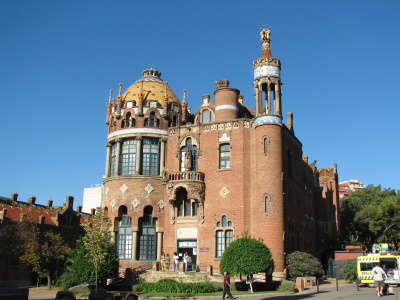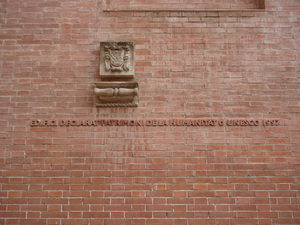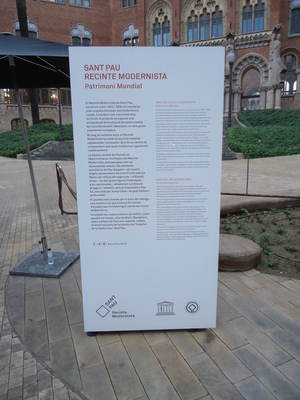Palau de la Musica Catalana & Hospital de Sant Pau

The Palau de la Música Catalana and the Hospital de Sant Pau, Barcelona are considered masterpieces of the exuberant Catalan Modernista style.
This style, similar to Art Nouveau, flowered in early 20th century Barcelona. The Concert Hall and Hospital were designed by the Catalan architect Lluís Domènech i Montaner. In both buildings, he made use of new technologies developed during the industrial revolution, such as a steel frame, and beautiful decorative motifs.
Community Perspective: The Palau can be visited on a guided tour or enjoyed during a concert, while the former Hospital grounds will need a tour too.
Map of Palau de la Musica Catalana & Hospital de Sant Pau
Load mapCommunity Reviews
Kyle Magnuson
California - United States of America - 29-Dec-24 -

From the Sagrada Familia station its a pleasant walk to the Hospital de Sant Pau via the Av. de Gaudí. Self-guided tours within Sant Pau are now €17 and can be reserved online. We started just as the site opened and we pretty much had the complex to ourselves for the first 30-60 minutes. The ensemble of buildings are really impressive and access seems much improved compared to the past. In the morning light with a blue sky, each building, rooftop, mosaic and interior was highly picturesque. Lluís Domènech i Montaner designed other buildings in Barcelona, including the Castell dels Tres Dragons and the Casa Lleó Morera. Montaner will largely be an unknown name to the millions of international visitors to Barcelona as the allure and fame of Gaudí has overshadowed him, no street names for Lluís Domènech i Montaner! Setting aside the 'Works of Antoni Gaudí' for a day, we focused our admiration on these iconic works of Catalan Modernism or sometimes referred to as Catalan Art Nouveau. We honored his masterworks by a visit to Sant Pau in the morning and a reserved concert performance in the evening at the Palau de la Musica Catalana.
As part of the Festival of Jazz, I discovered a few months before our trip that María José Llergo would be performing during our stay in Barcelona. What incredible fortune! Indeed, an artist I only recently discovered while watching NPR's Tiny Desk Concerts! The price was €52 per person, which compared to Los Angeles is a great deal. While waiting to be allowed in the concert hall, you can enjoy a glass of wine at the Bar del foyer. We arrived early and were rewarded, as the first guests were allowed in with about 30-40 minutes before the performance to simply stroll within the glorious interior of the Palau de la Musica Catalana and take as many photos as we wished. When the performance began with a packed audience, the evening was simply wonderful. The stained-glass skylight changed color during the performance to dark blue, violet, green, and red. María José Llergo shared how performing at the Palace of Catalan Music had always been a dream of hers and you can understand why any performer would revel in the opportunity. An unforgettable experience for sure and one that I am certainly grateful to have shared with my spouse.
Read more from Kyle Magnuson here.
DutchHorn

In the summer of 2010, I was in Barcelona for the 2010 EAGE conference. One day I had an evening to go for a walk in town and find this WHS. I also walked along the Ramblas and found the old hostel I stayed at during previous Barcelona trips. This site is a pretty building from the outside, but not that impressive in my view.
Apparently, the inside is quite impressive and the other building that is part of this WHS is quite nice as well. I was actually a bit disappointed that downtown Barcelona does not have more sites. This city seems to have so much old and new history that I would think there would be more interesting sites.
Jay T

Sometimes when you travel with family or friends, you are limited in the amount of time you can spend visiting World Heritage Sites; accordingly, my visits to the Palau de la Música Catalana and the Hospital de Sant Pau in May of 2013 were quite literally superficial. In some ways, I didn't mind, since I rather prefer Art Deco-style architecture to Art Nouveau, but I would have liked to have seen the insides of both buildings, which were designed by local architect Lluís Domènech i Montaner in the early 20th century. When I visited the hospital, a large crane was in front of the building, so we didn't spend much time there beyond taking photos. I was able to visit the Palau twice during my time in Barcelona, but was unable to take a tour because we arrived at the wrong time of day (which didn't particularly bother my friend who was by this time very tired of visiting museums or buildings). I appreciated the outside of the Palau, with its distinctive columns, mosaics, and tilework; however, it is very hard to photograph because of all the surrounding buildings. One day I'll have to return to see the inside, which looks fascinating in photos.
Logistics: Both sites are accessible by Barcelona's Metro system. The Palau de la Música Catalana can be reached via the Urquinaona stop on Lines 1 and 4; the Hospital de Sant Pau can be reached via the Sant Pau/Dos de Maig stop on Line 5 or the Guinardó/Hospital de Sant Pau stop on Line 4.
Tom Livesey
My trip to Barcelona in March 2015 was initially sparked by a desire to attend an artichoke festival. That turned out to be disappointment, but the trip was made worthwhile by the gem that is this Art Nouveau WHS.
Whilst the tour was great, clearly the best time to visit the wonderful music hall for a performance must be a matinee, when you can benefit from the vast amount of natural light that floods into the hall through the side and rear windows and of course the magnificent skylight, nicknamed ‘the Glowworm’.
A short metro ride away is the Hospital. We accidentally went into a modern working hospital before being directed round the corner to the Modernist original. It has the feel of a small city, consisting of something like 27 separate buildings, connected by underground service tunnels.
Hubert

These two monuments of the Catalan Modernisme by Lluís Domènech i Montaner are at least as impressive and spectacular as the works of his more famous contemporary Antoni Gaudi. The magnificence of the sites are adequately described by the previous reviews. So just a few recent information that might be of interest for future visitors.
The historic buildings of the Hospital de Sant Pau are no longer in use as a hospital (since 2009). On our visit in May 2014, the renovation was almost complete. The central area of the complex can be visited either with a guided tour (14 Euro) or self-guided (8 Euro). This zone comprises the most fascinating buildings: the administration building, eight large and two small pavilions, and the central pavilion (the former surgery building). Three pavilions are open to visitors: the administration building with the amazing main hall, a small pavilion (Sant Jordi) with an exhibition about the restoration, and the Sant Rafael pavilion whose interior has been restored in the original design, so that you get an impression how it would have been as a patient here. All other pavilions are or will in the future be used as offices for academic institutions. The buildings outside the museum area houses facilities of the new hospital and the university and are not accessible. These buildings were completed after Montaner's death by his son Pere Domènech i Roura. Unfortunately the church was closed for renovations and there were still some building site fences in the outer areas. So perhaps the visitor area will be extended in the future.
The Palau de la Musica Catalana is a masterpiece of the Catalan Modernisme. You should not be deterred by the steep fee for the guided tour (18 Euro), a visit is worthwhile. The tour starts with a video, then you'll see the beautiful vestibule and the staircase, and finally the main concert hall. All is sumptuously decorated with ceramic mosaics, stained glass, and sculptures. The highlight is undoubtedly the stained-glass skylight (photo) in the shape of an inverted dome. And in contrast to previous reviews: we were allowed to take photos everywhere inside the building.
Daniel C-Hazard
The guided visit to the Palau de la Música Catalana is well worth the entry fee (in my opinion better value for money compared to some of the Gaudí buildings). A very interesting film covers the history of the building and of the Eixample district. You will then have enough time to enjoy the amazing interior of the concert hall with its stained-glass skylight. The Hospital de Sant Pau is also a great place to discover.
Clyde

I visited this WHS in November 2007. These Art Nouveau buildings in Barcelona blend in pretty well with the other buildings of the city. The highlight of my visit was the Pau Hospital steel-framed structure with the 'clock tower'.
Ivan ManDy
One of my biggest disappointments in Spain was not being able to see the inside of the Palau Musica but the Hospital was really something to remember Barcelona by. I think its a great tribute to the city's other artistic genius Mr. Montanner that UNESCO declared his masterpiece a WHS...really a nice change after all the Gaudi disneyland theme. ;o)
Els Slots

A working hospital could easily be the most impressive architectural sight in Barcelona. We stayed in a hotel just around the corner (Medium Medicis, well recommended), and that way observed the coming and going of the hospital every morning. Ambulances with their sirenes turned on speeding past, or nurses and doctors dropping in on one of the cafés to buy some delicious fresh bread.
Despite all this bustle, you are free to walk in the grounds. The hospital covers a large area and consists of several pavillions (27), all with their own characteristics. It was designed in such a way that the patients could stay in pleasant surroundings so they would feel better.
The Palau de la Música Catalana, located in Barcelona's city center and hidden behind a glass front, is also very worthwhile to visit. You can only get in via one of the guided tours, which are conducted frequently. First, a video is shown about the origins of the Palau, founded by the Orfeo Catalan (choir society). Then you are taken via the grand stairs to the main theatre. Sculptures represent the popular and classical music that is played here. A large stained glass object in the ceiling symbolizes the sun.
Klaus Freisinger
I can only second the glowing reviews posted here. In what is a great city to begin with, these two buildings by the Catalan Art Nouveau architect Lluís Domènech i Montaner stand out even by Barcelona´s very high architectural standards. The hospital is probably like no other in the world (and the only one I´ve ever come across that is mentioned in a guidebook), and even though a new hospital is currently being built, it´s still a working place with real patients inside; it´s within easy walking distance of the Sagrada Familia. The Palau de la Música Catalana, located close to the Cathedral in the Barrio Gótico, is not terribly impressive from the outside, but the inside, especially the auditourium, is just fantastic. Even if you´re not really into classical music, it´s well worth the long wait in line to get tickets for a guided tour (if English is sold out, you could still try Spanish or Catalan, even if you don´t understand it, since the important thing is to SEE the inside!). Two of the finest buildings I have ever seen, and a must when coming to Barcelona.
Rob Wilson
The Palau certainly has a nice facade, and is apparently a great place to see a concert (unfortunately I didn't get to see one). The Hospital though is excellent. Clearly an architects folly, that paradoxically has a genuine use. The buildings are beautiful and in great condition. What's more, it's free to walk around the grounds. It is well worth a visit if you're in the area.
Ian Cade

The two buildings on here are quite a way apart from each other in Barcelona but can both be seen easily if you want to spend a couple of hours touring this fantastic cities main sites.
The Hospital San Pau is very impressive and just up the road from Gaudi’s famous Sagrada Familia so makes a great reason to travel up to see it. The decoration is fantastic and it seems hard to believe that this is still a functioning hospital as the level of design that has gone into it is immense.
The Palau de la Musica Catalana has an impressive façade that is hard to take in due to the tight nature of the Barri Gothic area, if you can get inside though it is massively impressive. The tour costs €8 and includes a video introduction but nothing can compete with the main auditorium which is absolutely stunning. The place seems to just ooze music knowledge and again the craftsmanship is apparelled, and the stained glass roof was perhaps the highlight of the whole city for me it is just a staggering piece of work and the only time I have seen 3-D stained glass worth the admission price in itself. There is only one problem and that is you are not allowed to take any photos inside!
Vincent Dwyer
Based in Spain (from New Zealand) - 01-May-05 -
The Palau de la Musica is an amazing building. Guided tours are offered on a daily basis, but the best option is to try and get tickets to a concert during your stay in Barcelona. The Palau is easy to find, just off Via Laietana, (nearest Metro: Urquiniona) and a short walk from the Cathedral.
Hospital Sant Pau is an excellent example of modernist architecture. It is free to enter the gardens, where you can observe the different buildings which are still in use. The nearest metro is on the blue line (Sant Pau), but I would recommend you combine this visit with one to the Gaudi cathedral (La Sagrada Familia). The two sites are close. You can walk from one to the other along Avenida Gaudi in less than 10 minutes.
More information on both these sites is available on my web site: bestofbarcelona.com
Community Rating
- : David Berlanda Inigo Cia Cezar Grozavu Craig Harder Kim, Soo-youn Stanislaw Warwas Lukasz Palczewski Ilya Burlak Can SARICA Thomas Kunz Farinelli Disnsam Thomas Harold Watson Gillian Taylor Sebasfhb Persian Globetrotter Ovalarezo Dolemite92 Mikhail Ming_9734
- : Kyle Magnuson Wojciech Fedoruk Aitia Christoph JobStopar Shoaibmnagi Miri2808 Collisions
- : Ian Cade Frederik Dawson Nikolay Marinov Hubert Zhenjun Liu Svein Elias Alexander Parsons Zoë Sheng J. Stevens Shandos Cleaver Don Irwin Purrfect Richard Stone Dorejd Aspasia Kbtwhs Priyaranjan Mohapatra Zach Ih0000 Boppare JJ10 Jxrocky MC Javier
- : Els Slots Klaus Freisinger Assif Daniel C-Hazard Peter Lööv Jan Zimmermann Randi Thomsen Mike Chenboada Daniel Gabi Nikolamus Reisedachs Christravelblog Tevity Lucio Gorla Rodinia DavidS Juropa Tingmelvin CugelVance Emily Cullen Ssong.x Manuelfunk Csaba Nováczky AS KngAlaric
- : Solivagant Tony H. Roman Raab Philipp Peterer Ivan Rucek Martina Rúčková João Aender Aljaz Dwight Zehuan Xiao George Gdanski Mohboh Aidan Coohill Tarquinio_Superbo Doubanjiang Daniel R-F Philipp Leu Inomusay Cutecid Napalm J_neveryes Oscar Wu
- : Gary Arndt Caspar Dechmann Nan Argo Matejicek GabLabCebu NonDuality Mo-han Je DutchHorn
- : Stanimir Jay T Sncjob Frédéric M VLabhard AT8 JLuth
- : Clyde
Site Info
Site History
1997 Inscribed
Site Links
Unesco Website
Official Website
Related
Connections
The site has 13 connections
Art and Architecture
Constructions
Timeline
Trivia
WHS Hotspots
Visitors
534 Community Members have visited.
The Plaque
 (photo by Jarek)
(photo by Jarek) (external source)
(external source) (photo by Jarek)
(photo by Jarek)